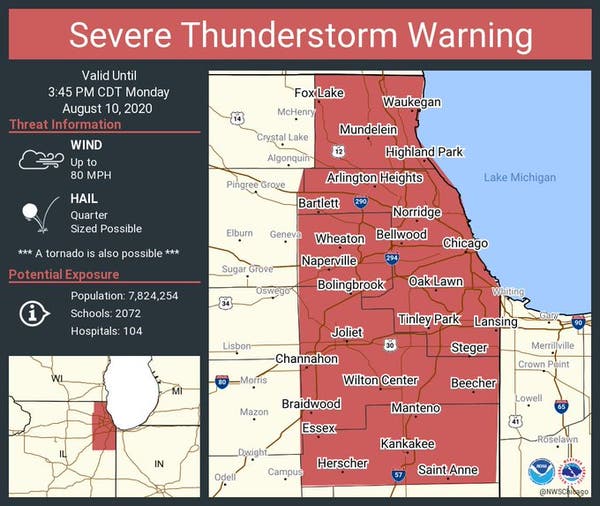Watch Out For Damaging Winds: Fast-Moving Storms

Table of Contents
Understanding Fast-Moving Storms
Defining Fast-Moving Storms
What constitutes a "fast-moving storm"? The key is speed and the often-linear nature of the storm's movement. Unlike slow-moving hurricanes or tropical storms, fast-moving storms can travel at speeds exceeding 60 mph (97 km/h), sometimes even reaching 75 mph (121 km/h). This rapid movement often leads to concentrated bursts of damaging winds over a relatively short period. Derechos, for example, are a particularly powerful type of fast-moving storm characterized by widespread damaging winds extending for hundreds of miles. Squall lines, another significant type, are bands of thunderstorms often associated with cold fronts, also capable of producing intense, damaging winds.
- Definition of fast-moving storms and their typical characteristics: Fast-moving storms are characterized by their rapid translation speed, often exceeding 60 mph, and intense, damaging winds. They can be associated with various weather systems, such as derechos, squall lines, or even embedded thunderstorms within larger systems.
- Speed ranges associated with different types of fast-moving storms: Derechos can travel at speeds of 60-75 mph, while squall lines can move at varying speeds depending on the atmospheric conditions, often ranging from 30-60 mph.
- Geographic regions more prone to these storms: The Great Plains of the United States are particularly prone to derechos, while squall lines can develop across various regions depending on weather patterns.
- Meteorological factors contributing to their rapid movement: Strong jet streams, steep pressure gradients, and the interaction of different air masses are some meteorological factors contributing to the rapid movement of these storms.
The Dangers of Damaging Winds
Types of Wind Damage
Damaging winds from fast-moving storms pose a significant threat. The intense wind speeds can cause a wide range of damage, impacting both property and human lives.
- Property damage examples (roof damage, broken windows, tree falls): High winds can rip off roofs, shatter windows, and uproot trees, causing significant structural damage to homes and businesses. The weight of fallen trees can further crush structures, and flying debris becomes a dangerous projectile.
- Injuries and fatalities caused by flying debris: Debris like broken branches, signs, and even parts of buildings can become deadly projectiles during high winds, leading to severe injuries or fatalities.
- Impact on infrastructure (roads, bridges, power grids): Fast-moving storms can down power lines, causing widespread outages and disrupting essential services. Roads and bridges can be damaged or rendered impassable, hindering emergency response efforts.
- Secondary hazards (flooding from dam breaks, gas leaks): Wind damage can indirectly cause other hazards. For instance, damage to a dam could lead to flooding, while downed power lines may cause gas leaks, leading to fires or explosions.
Preparing for Fast-Moving Storms with Damaging Winds
Developing a Preparedness Plan
A well-developed emergency plan is critical for surviving a fast-moving storm.
- Assembling an emergency kit (water, food, first aid, etc.): Prepare a kit containing essential supplies like water, non-perishable food, a first-aid kit, medications, flashlights, batteries, and a portable radio.
- Identifying safe rooms within the home: Locate a sturdy interior room, preferably on the lowest level, away from windows, to serve as a safe haven during the storm.
- Establishing communication protocols with family and friends: Designate an out-of-state contact person for family members to check in with during and after the storm. This helps ensure everyone is accounted for.
- Understanding local warning systems (alerts, sirens): Familiarize yourself with local warning systems, including weather alerts, sirens, and emergency broadcast systems.
- Knowing evacuation routes and shelter locations: Identify potential evacuation routes and designated shelters in your area beforehand.
Staying Safe During a Fast-Moving Storm with High Winds
Actions to Take During the Storm
When a storm warning is issued, immediate action is crucial.
- Seeking shelter immediately upon receiving a warning: Move to your designated safe room immediately when a warning is issued.
- Staying away from windows and doors: Avoid windows and doors, as they are vulnerable points during high winds.
- Unplugging electronic devices: Unplug electronic devices to protect them from power surges.
- Securing loose outdoor objects: Secure any loose outdoor objects that could become projectiles, such as furniture, trash cans, and garden decorations.
- Staying informed about storm updates: Continuously monitor weather updates through radio, TV, or reliable weather apps.
Recovery After a Fast-Moving Storm
Assessing Damage and Seeking Assistance
After the storm passes, carefully assess the damage and take appropriate steps.
- Safely inspecting property for damage: Carefully inspect your property for damage, but prioritize safety. Avoid downed power lines and unstable structures.
- Reporting damage to insurance companies and local authorities: Document the damage with photos and videos, and contact your insurance company and local authorities to report the damage.
- Safely handling debris and downed power lines: Never approach downed power lines; contact the power company immediately. Handle debris carefully, wearing appropriate protective gear.
- Seeking assistance from emergency services if needed: If you need emergency assistance, contact emergency services immediately.
Conclusion
Fast-moving storms and their associated damaging winds pose a significant threat, capable of causing widespread destruction and endangering lives. Understanding the nature of these storms, preparing a comprehensive emergency plan, and taking appropriate safety measures during and after a storm are crucial for minimizing risks. Protect yourself from damaging winds by being prepared. Be prepared for fast-moving storms by creating a detailed emergency plan, including an emergency kit, communication strategies, and evacuation plans. Stay safe during severe weather by staying informed, seeking shelter promptly, and following safety guidelines. Visit your local National Weather Service website for more information on severe weather preparedness in your area and to stay informed about weather warnings. By taking proactive steps, you can significantly reduce the risks associated with fast-moving storms and damaging winds.

Featured Posts
-
 Bribery Charges Navy Commander Burke Sentenced In Job Exchange Case
May 21, 2025
Bribery Charges Navy Commander Burke Sentenced In Job Exchange Case
May 21, 2025 -
 Analyse Van De Terugkeer Van John Lithgow En Jimmy Smits In Dexter Resurrection
May 21, 2025
Analyse Van De Terugkeer Van John Lithgow En Jimmy Smits In Dexter Resurrection
May 21, 2025 -
 Nyt Mini Crossword Answers March 13 Daily Solutions And Solving Tips
May 21, 2025
Nyt Mini Crossword Answers March 13 Daily Solutions And Solving Tips
May 21, 2025 -
 Aimscap And The Wtt Lessons Learned And Future Implications
May 21, 2025
Aimscap And The Wtt Lessons Learned And Future Implications
May 21, 2025 -
 Javier Baez Recuperacion Y Productividad En El 2024
May 21, 2025
Javier Baez Recuperacion Y Productividad En El 2024
May 21, 2025
Latest Posts
-
 Hurwitzs Early Vision Unveiling The Original Cobra Kai Trailer Pitch
May 23, 2025
Hurwitzs Early Vision Unveiling The Original Cobra Kai Trailer Pitch
May 23, 2025 -
 Cobra Kai Ep Hurwitz Reveals Original Series Pitch Trailer
May 23, 2025
Cobra Kai Ep Hurwitz Reveals Original Series Pitch Trailer
May 23, 2025 -
 Karate Kid Legend Of Miyagi Do A Franchise Timeline Explained
May 23, 2025
Karate Kid Legend Of Miyagi Do A Franchise Timeline Explained
May 23, 2025 -
 Connecting The Dots Legend Of Miyagi Do And The Karate Kid Universe
May 23, 2025
Connecting The Dots Legend Of Miyagi Do And The Karate Kid Universe
May 23, 2025 -
 Karate Kid How Legend Of Miyagi Do Fits Into The Larger Story
May 23, 2025
Karate Kid How Legend Of Miyagi Do Fits Into The Larger Story
May 23, 2025
